|
|
Post by chefying on Jun 26, 2014 16:00:54 GMT
wow chef...you're pictures collection are really cool. that's really a treasure!  Thanks andrea. I had a good time travelling. Now I am broke! siuyiu beat me to replying your question. Anyway, if I ever take Hua Diao wine, I like it warm, and with a piece of xuanmei - sour plum in it. Since I take it with sour plum (taste more mellow if you ask me), it does not make economic sense to buy top quality Hua Diao wine. The normal/average cooking wine would do just fine. Any left overs go to my kitchen and gets sizzled into my cooking - especially chicken. I think most "mi jiu" - rice wine in China is made with glutinous wine. I believe this is the case because glutinous rice has more "sweetness" in it carbohydrates (?) compared to normal rice. If I recall my chemistry, the yeast breaks down the carbohydrates into sugar, and then the sugar into alcohol. So it makes sense to use glutinous rice rather than normal rice. I assume that everyone just uses glutinous rice to make rice wine, so by default, the "glutinous" part of it was dropped and it got called "rice" wine instead of glutinous rice wine. I made glutinous rice wine once when I was in London. For some odd reason, I was desperate for some Chinese coq au vin - the type that southern chinese would prepare for the mothers in confinement. Anyway, I saw some rice yeast being sold, so I bought the rice yeast, glutinous rice, and voila, a month later, I was cooking Chinese coq au vin. The wine turned out very sweet, and very strong. I also used the lees to cook chicken and that come out quite nice as well. That was a Eastern Chinese dish that I saw in a recipe book. At that point in time, I did not know of "jiu niang tang yuan" 酒酿 汤圆 - which was a blessing because I would be quite drunk quite often for quite long if I keep taking the "jiu ninag tang yuan". Talking about Xi'an, I am tempted to go again! I am eyeing October. Over there, at that time, there is a shop in Xi'an that sells a 'cake' made in a special way. This shop only opens for a few weeks in a year. In October, there are plenty of very ripe persimmons in Xi'an. That shop will squeeze the juice out of the persimmon, and use the juice to mix with the glutinous rice flour to form the dough of the cake. The filling of the cake is a mixture of peanuts, sugar, sesame seed, walnuts and osmanthus sugar. This mixture is wrapped in the aforementiond dough, and fried on a flat pan with some oil. Eaten warm in October, the dough is a bit chewy while the filling is delicious and fragrant. I have used this filling for my tang yuan served during Winter Solstice, and it came out great. Hmm, small wonder I am not fatter than I already am.... |
|
|
|
Post by chefying on Jun 28, 2014 10:01:08 GMT
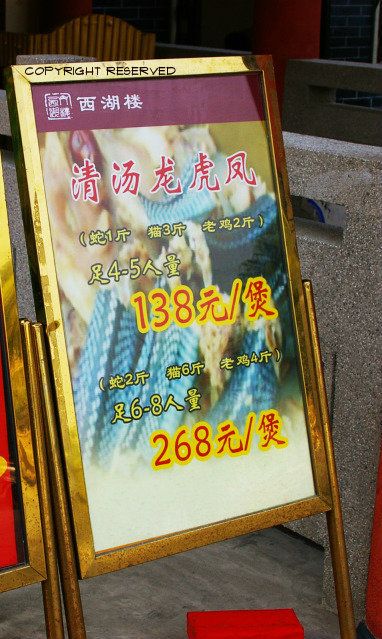 For the benefit of those who do not read Chinese, this sign outside a restaurant is recommending a broth prepared from one 斤(500g) snake meat - Dragon, three 斤 (1.5 kg) cat meat - Tiger, and two 斤 (1 kg) matured chicken - Phoenix. A serving sufficient for 4~5 persons costs RMB138 (approx USD23) while a serving sufficient for 6~7 persons costs RMB268 (approx USD45). Please bear in mind this photo was taken in 2006 and prices would most probably had increased since then. Please also note that China had re-scaled it weight measure, the "Jin" - catty. In present day China, one 市斤 - market "jin" - is 500g (used to be 600g) while a 公斤 standard "jin" is 1000 g, i.e. one kilo. Meanwhile, it used to be that 16 "liang" (tael) 两 make one "jin" of 600g, but now, the usual/official weight measure in China is 10 "liang" of 50g makes one market "jin" of 500g. |
|
|
|
Post by chefying on Jun 30, 2014 15:31:40 GMT
I managed to dig up a photo of a side-street in Kaifeng 开封, the Capital of Southern Sung Dynasty. It is also famous for being the residence of Bao Ching Tian, 包青天 one of the main characters in the wuxia novel Seven Knights and Five Gallants 七侠五义. This photo had faded in time, so I converted it to black and white. 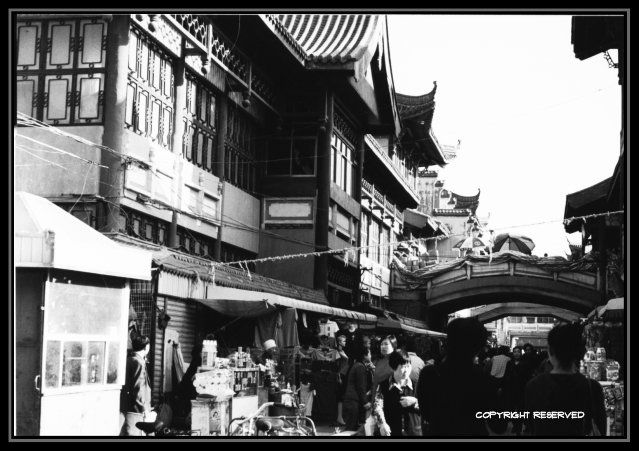 Kaifeng, 开封 was known as Kaifeng Fu 开封府 during the Sung Dynasty. This is a picture of the outside the main prayer hall of Xiang Guo Si 相国寺. In the book, "The Water Margin" 水浒传 , while fleeing from the authorities, Lu ZhiShen 鲁智深 disguised himself as a monk and hid out in this temple. Part of the name of the temple can be seen on the incense burner. 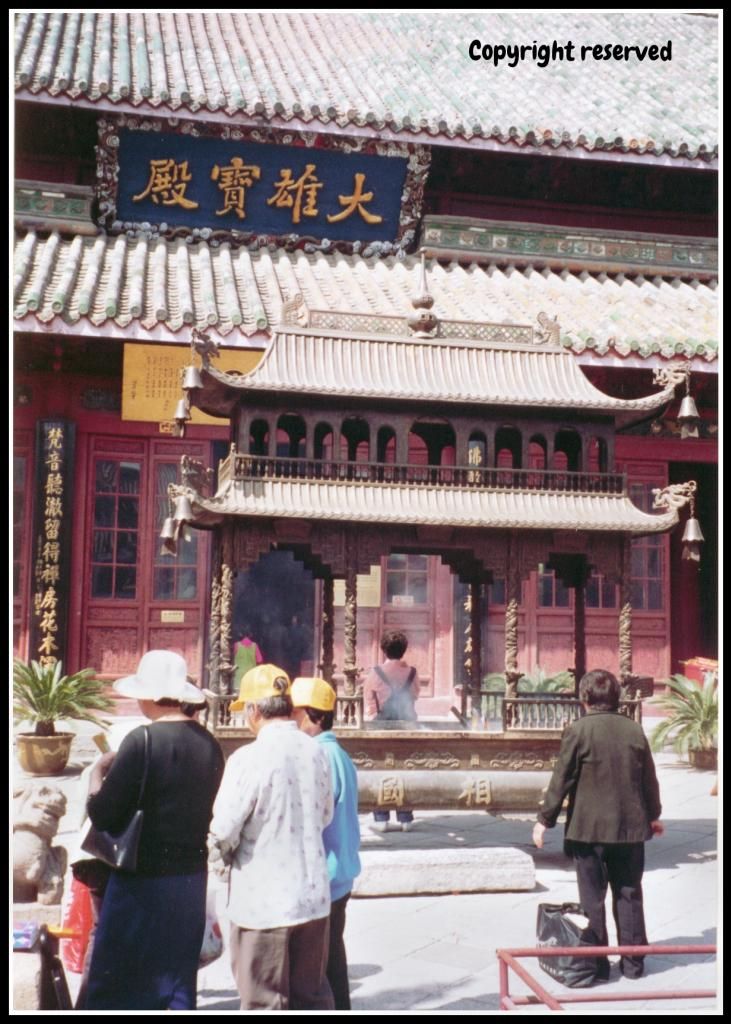 |
|
|
|
Post by chefying on Jun 30, 2014 15:46:30 GMT
This is Suzhou, famous for its silk industry in the olden days. The businessmen there made money and spent it building beautiful gardens and bridges. This is a photo I took in one of the gardens I visited - I think it was the Fisherman's Garden. 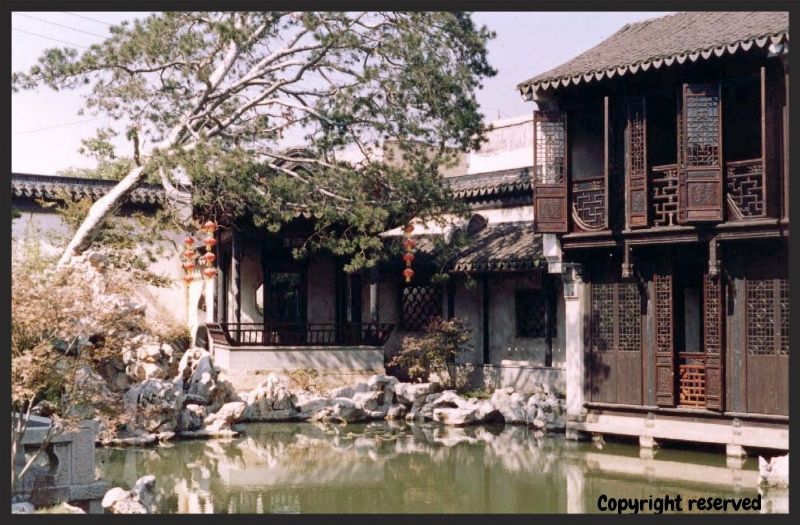 I wanted to make the photo a bit more interesting by including myself in it a la Brussels' Mannekin Pis but there were too many people there and I was a bit shy. While in Suzhou, I visited the Cold Hill Temple, Han Shan Si 寒山寺 made famous by the poem 枫桥夜泊 by the Tang Dynasty poet, 张继. 月落乌啼霜满天,
江枫渔火对愁眠。
姑苏城外寒山寺,
夜半钟声到客船。
Now, as a by the by, if you think Suzhou is picturesque and all, be warned, capitalism has taken deep roots here. 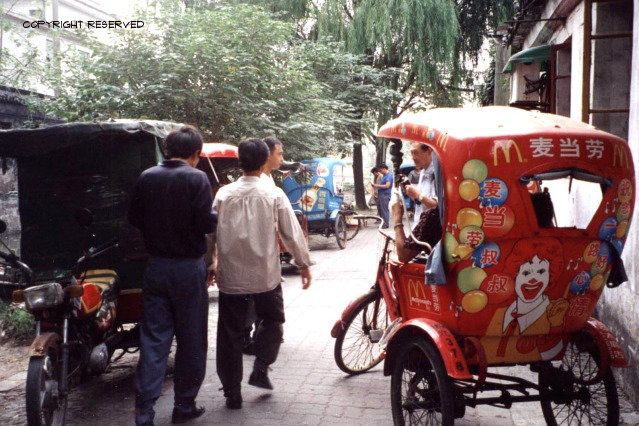 |
|
|
|
Post by chefying on Jul 1, 2014 15:31:43 GMT
I took a night ferry from Suzhou to Hangzhou. The pictures I took on that trip had been posted here. Hangzhou was the setting for the Legend of the White Snake. It was there that Lady White Snake fell in love with a mortal, and events stemming from that led her to being imprisoned in the pagoda in the middle of Xi Hu, 西湖, West Lake. 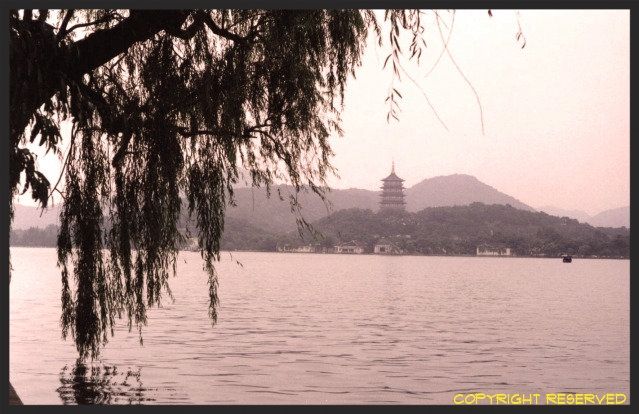 In Hangzhou and many other parts of China, children are put into these "Split Pants" - these are warm, and the slit/split allow the disposal of body waste without having to remove the pants.  |
|
|
|
Post by chefying on Jul 2, 2014 15:54:49 GMT
I suppose the next place to cover in the general Jiangnan area (as in Jin Yong's "Seven Freaks of JiangNan" 江南七怪 from Legend of the Condor Heroes) would be NanJing. Nanjing 南京 means Southern Capital - while Beijing 北京 means Northern Capital. Nanjing, the Capital City of the Province Jiangsu, was the initial capital of the Ming Dynasty. It was the third Emperor of the Ming Dynasty, Emperor Yongle 永乐 who moved the capital from Nanjing to Beijing. During the Southern Tang Dynasty Nanjing was called Jinling. In the (non-wuxia) novel, Dream of the Red Chamber, the twelve beauties in the book were collectively known as Jinling ShiEr Chai 金陵十二 - the Twelve Hairpins of Jinling. Going back further in history, it was the Capital of Sun Quan 孙权 of the Wu 吴 Kingdom in novel, Romance of the Three Kingdoms. The Nanjing City Wall we now see was (re)built by the first Emperor of the Ming Dynasty, Zhu Yuanzhang. Zhu Yuanzhang 朱元璋 was mentioned in Jin Yong's book Heaven Sword and Dragon Sabre, YiTian TuLong Ji 倚天屠龙记. Zhonghua Men 中华门, the South city wall gate of Nanjing. is really impressive. You many notice that this wall is three layers thick.  There is a famous temple in Nanjing called Confucius Temple 夫子庙 (I am not a fan of Confucius). 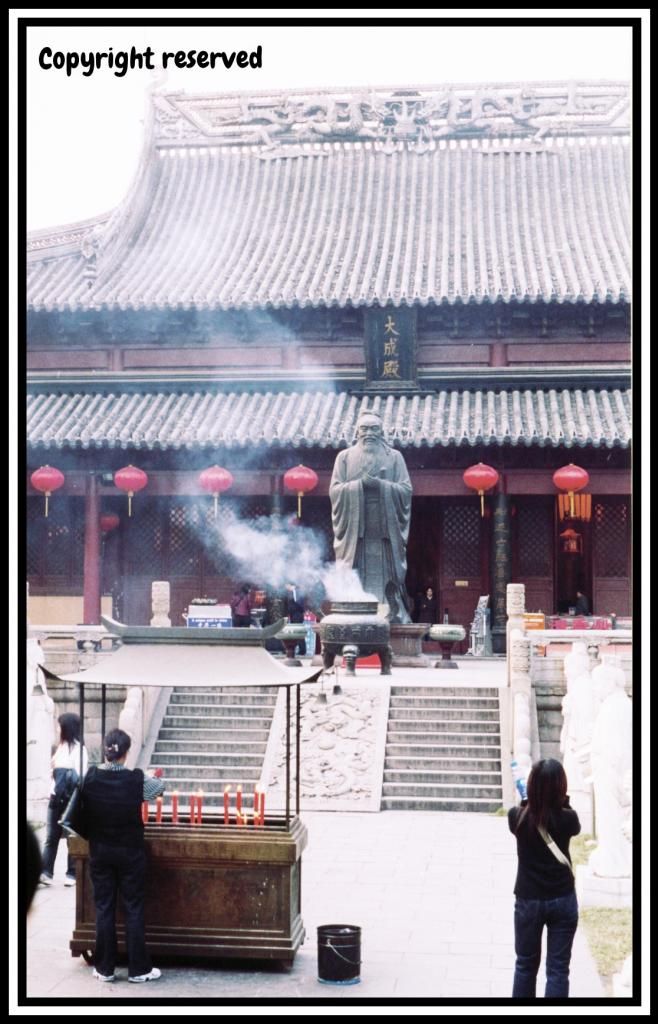 Presumably, people would come here to pray before they sit for the Imperial Exams. I am not sure if the exam hall was next to this temple a few hundred years ago, but now, there is a mock-up of one a few steps away from the Confucius Temple. This is what a candidate's niche looks like, and presumably, they will be scratching their heads in a similar manner as that depicted in this photo. Needless to say, the candidates were not as good looking as the model in this picture (joke). 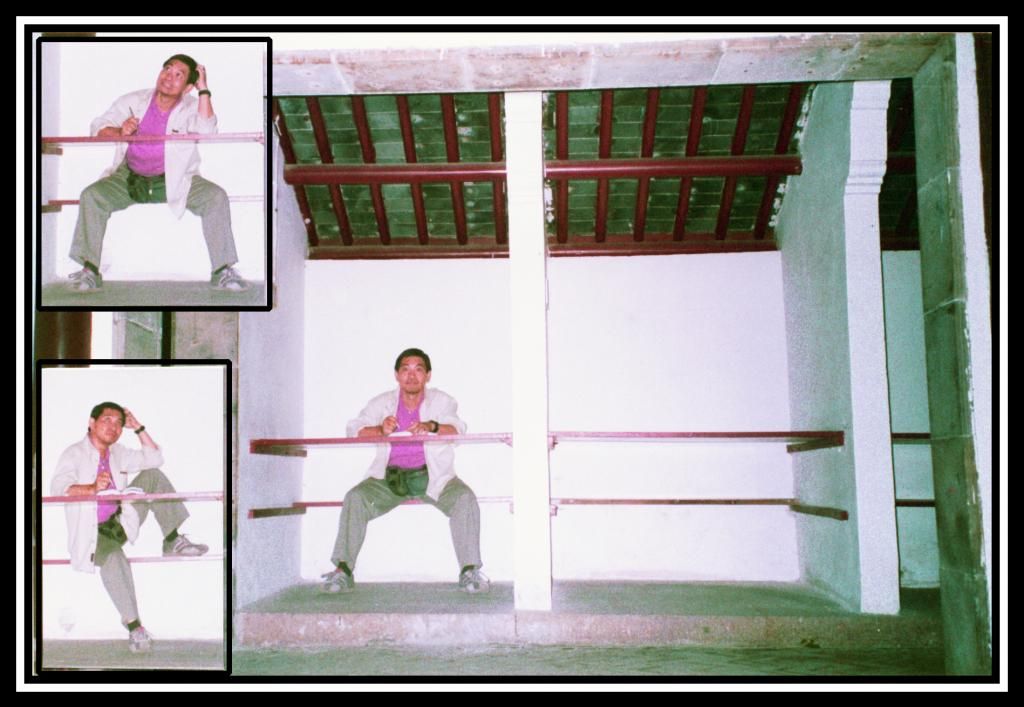 By the way, I understand that the exam candidates are required to be in this niche for a few days until the exams are over. They are not allowed to leave - or rather, once they leave they are not allowed to re-enter. In the Imperial Exams 科举, the graduates are called jinshi 进士. The top scholar among the jinshi is known as zhuang yuan 状元, the second (first runner-up) is called bangyan 榜眼 while the third (second runner-up) is called tanhua 探花. In Gu Long's XiaoLi FeiDao series, Flying Dagger Li is also known as Li Tan Hua - which would infer that Flying Dagger Li had put in time on both his books and his flying dagger. When I was in PingYao Town, ShanXi Province, I saw this punny photo - it would make sense if you know Chinese. Anyway, ShanXi province is famous for it DaoShua Mian, literally, Knife Shaved Noodles. The dough is kneaded, then hand held and bits of the dough is sliced, with the sliced bits falling into a cauldron of hot water. This sliced dough, once cooked in the cauldron of hot water, is the "noodle" which is then served hot, usually in a soup. This sign says XiaoLi Fei Dao Shua Mian, combining the Li's Flying Dagger with the Knife/Dagger Sliced Noodle. 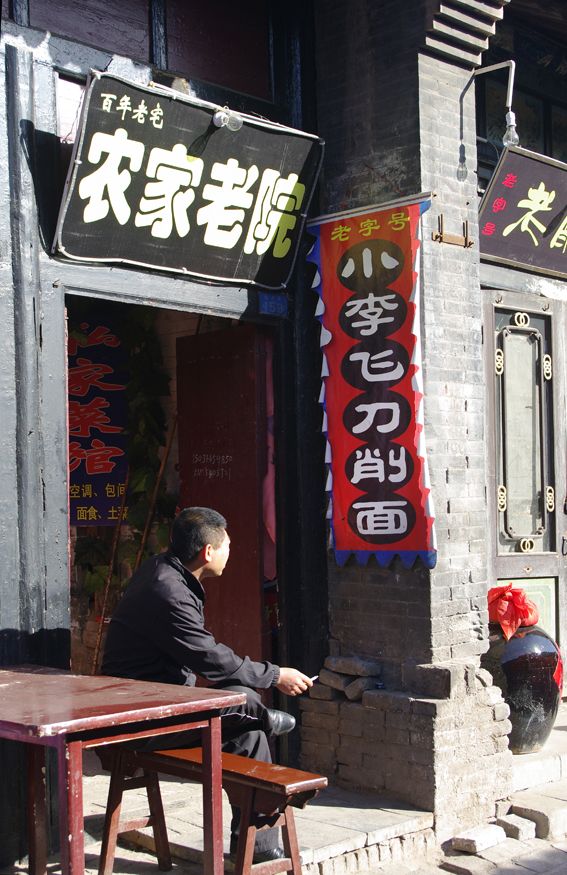 Meanwhile, in the City of DaTong, ShanXi Province, they made a machine do the slicing of the DaoShua Mian. Why they had to evoke Ultraman, I have no idea... 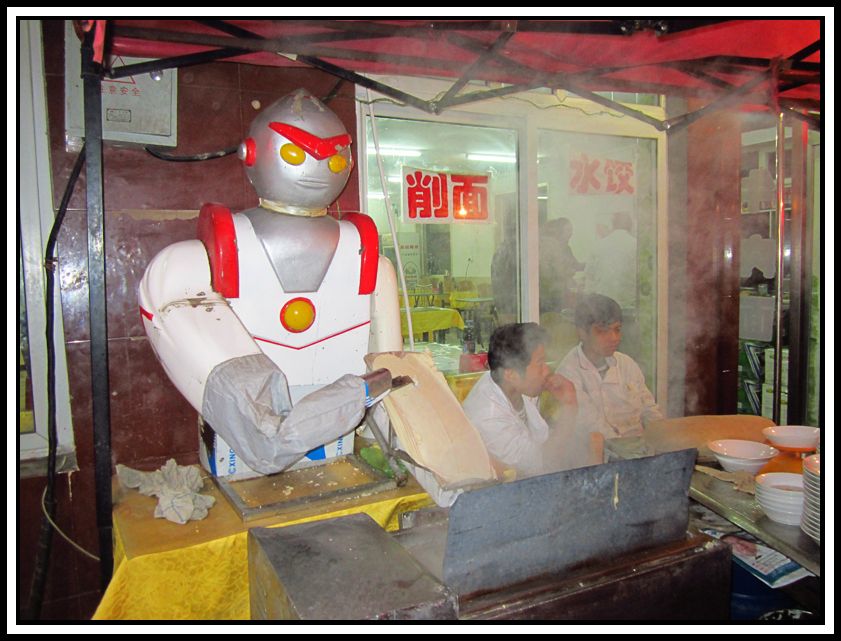 |
|
|
|
Post by siuyiu on Jul 2, 2014 18:07:04 GMT
When I was in PingYao Town, ShanXi Province, I saw this punny photo - it would make sense if you know Chinese. Anyway, ShanXi province is famous for it DaoShua Mian, literally, Knife Shaved Noodles. The dough is kneaded, then hand held and bits of the dough is sliced, with the sliced bits falling into a cauldron of hot water. This sliced dough, once cooked in the cauldron of hot water, is the "noodle" which is then served hot, usually in a soup. This sign says XiaoLi Fei Dao Shua Mian, combining the Li's Flying Dagger with the Knife/Dagger Sliced Noodle.  i'm guessing the stall would have to be heavily padded to prevent dagger li's knife from ricocheting off the walls.  |
|
|
|
Post by chefying on Jul 3, 2014 17:29:22 GMT
XiAn 西安 is the capital of 13 Chinese Dynasties, and is the end of the Silk Route. It is now famous for the Terra Cotta Army made under the orders of the First Emperor of the Qin Dynasty as his burial accompaniments. During the Tang Dynasty, this was also where Monk Tripitaka - Tang SanCang 唐三藏 set off to India to bring back the Buddhist Scriptures. His exploits was fictionised into the story, Journey to the West. Upon the monk's return, he settled into the Big Goose Pagoda Temple 大雁塔 to translate the sutras. Journey to the West asides, I would presume Monk Tripitaka would know some martial arts to fight off the brigands he must have encountered along the way. The Big Goose Pagoda Temple - inset is the pagoda on a polluted day in XiAn. 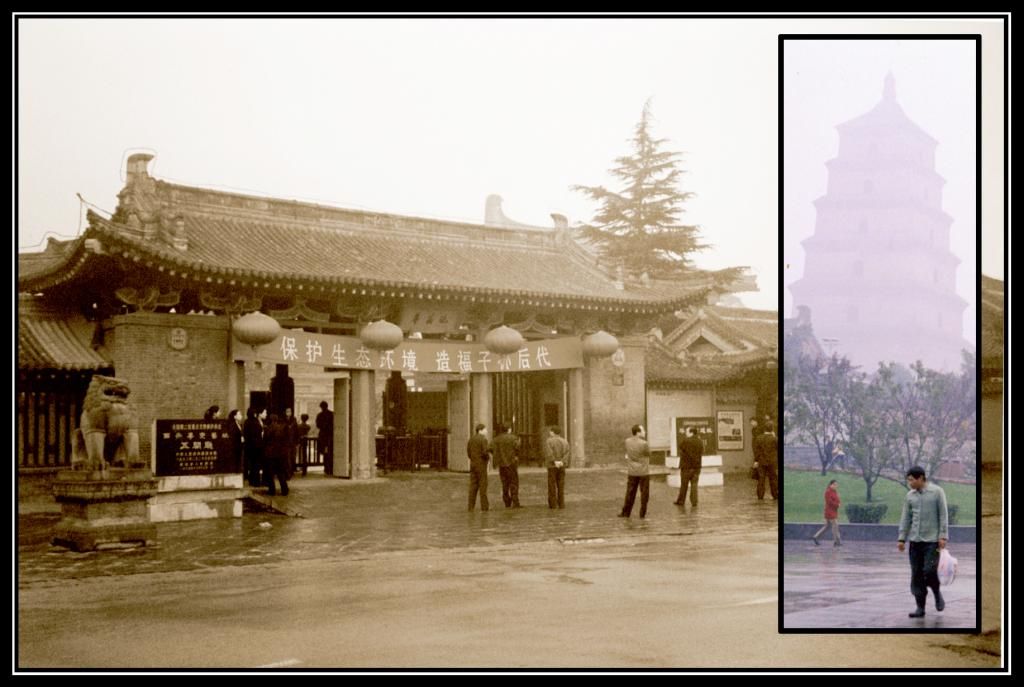 Hua Qing Ci 华清池 was the hot spring where Lady Yang bathed. When she emerged in the altogether, her altogether beauty captured altogether the love of the Tang Dynasty Emperor. The poet Li Bo 李白 (as a name, it is pronounced Li Bo, not Li Bai) wrote of the infatuation... 后宫佳丽三百人,
三百宠爱在一身 Three hundred beauties are there in the Inner Palace The love for all the three hundred was concentrated on one person I too took a bath in the hot springs. When I emerged in my altogether, I was not receive with the same infatuation. Her bath, (purportedly)... 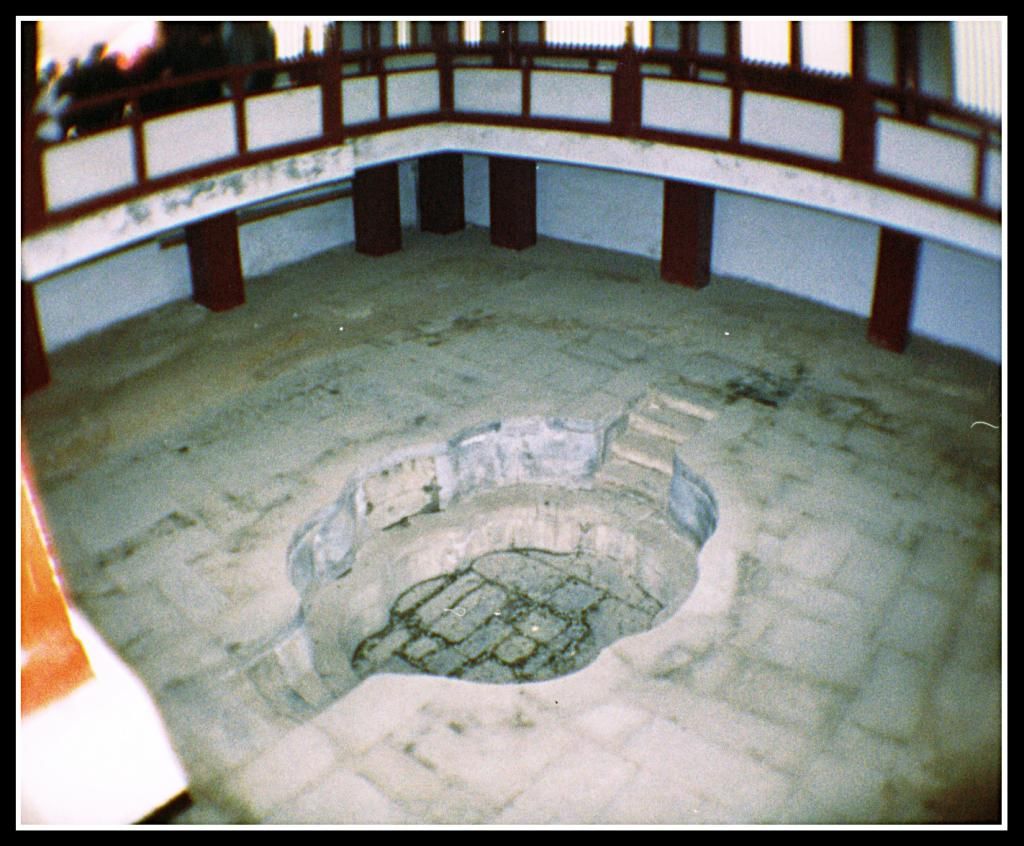 But all in all, Hua Qing Chi is a pretty place - despite the polluted air. 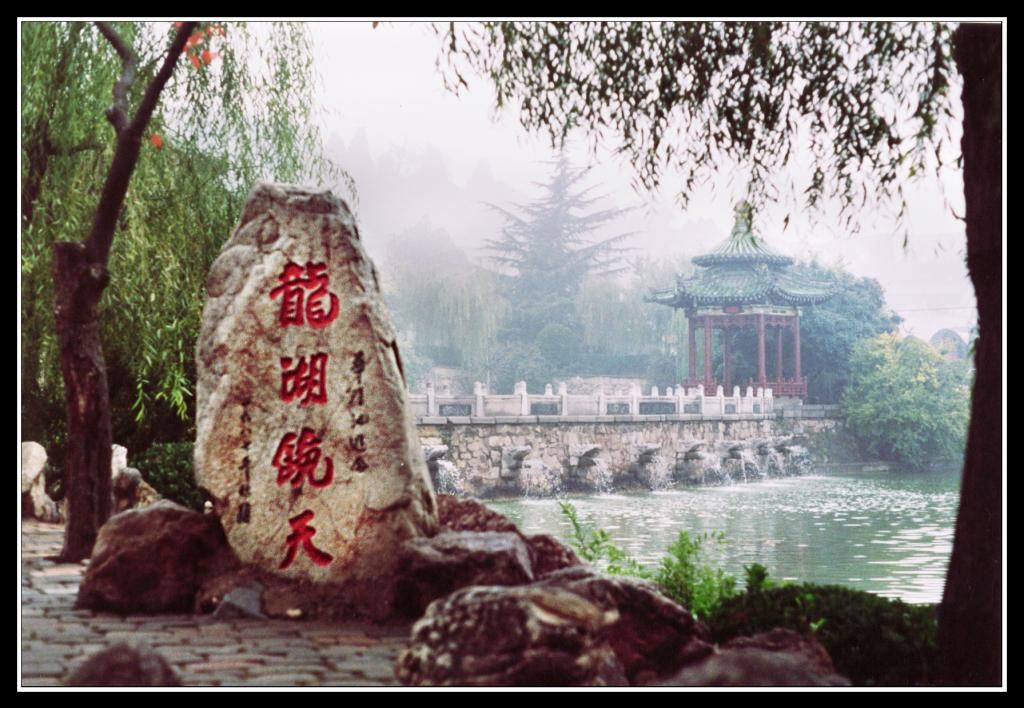 |
|
|
|
Post by chefying on Jul 3, 2014 17:39:38 GMT
When I was in Xi'an, I visited a Taoist Temple, variously known as Ba Xian An/Ba Xian Miao. Ba Xian refers to the Eight Immortals. "An" is a nunnery while "miao" refers to a Taoist temple. (A Buddhist Temple is known as "Si") To my surprise, I found a room/wing that is dedicated to our old friend, Qiu Chuji. Qiu Chuji was one of the priests from the QuanZhen Sect in Jin Yong's book, Legend of the Condor Heroes. This wing of the temple looks thus - it is now the living quarters of some of the Taoist Priests of this temple. 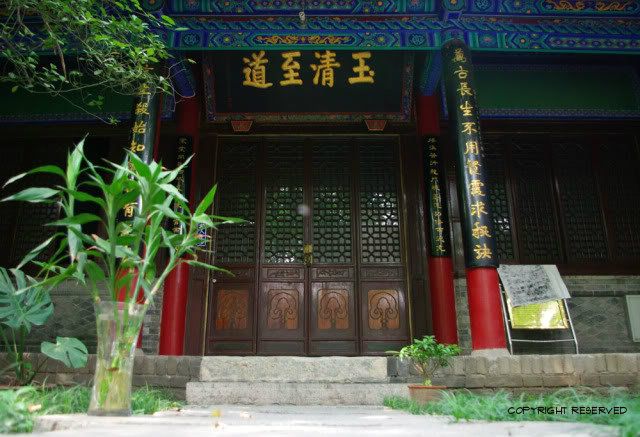 There is a brass plate explaining that this wing is actually dedicated to Qiu Chuji, and names him as the founder of the Quan Zhen Sect. This room was actually used as the temporary dwelling place of Empress Dowager Cixi when she fled from the attack of the armies of the Eight Nation Alliance sacked Beijing in 1900. (The Eight-Nation Alliance was an alliance of Austria-Hungary, France, Germany, Italy, Japan, Russia, the United Kingdom, and the United States.) 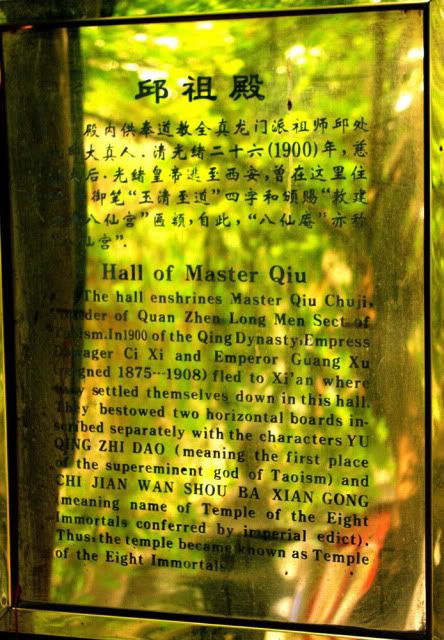 Upon her return to Beijing, the Empress Dowager bestowed upon this temple a plaque with the words 玉清至道 in her own handwriting, which was deemed a great honour. 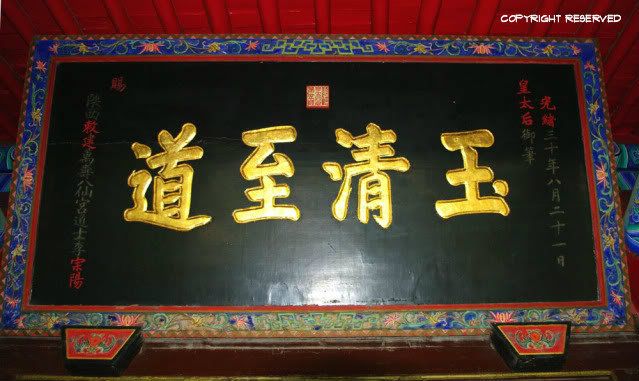 I found the Ba Xian Temple interesting, and I like the low admission fee - I think it was about RMB10 or something. This room was actually a wing off the main hall in the temple. I was being a busy body and just wandered around the temple hoping to find an interesting shot when I came upon this room. Of course I had to peek inside to have a look around. There was a priest in there, resting on a reclining chair. Unfortunately, he saw me too, and shoo'ed me away. That was when I noticed and realised it is now part of the living quarters of the priests - and I just invaded their privacy. |
|
|
|
Post by Admin on Jul 5, 2014 15:25:30 GMT
Interesting indeed:) 小李飞刀削面。。。I guess the shop owner must be a big fan of Li Tanhua  |
|
|
|
Post by yenchin on Jul 6, 2014 2:08:24 GMT
There is a brass plate explaining that this wing is actually dedicated to Qiu Chuji, and names him as the founder of the Quan Zhen Sect. This room was actually used as the temporary dwelling place of Empress Dowager Cixi when she fled from the attack of the armies of the Eight Nation Alliance sacked Beijing in 1900. (The Eight-Nation Alliance was an alliance of Austria-Hungary, France, Germany, Italy, Japan, Russia, the United Kingdom, and the United States.) Historically, the QuanZhen Sect was split into seven branches, each created by the disciples. Qiu ChuJi created the Long Men (Dragon's Gate) branch. en.wikipedia.org/wiki/Quanzhen_Schoolen.wikipedia.org/wiki/Dragon_Gate_TaoismNowadays they's still training and practicing. Not sure about the other branches but it seems that their teachings at least were passed down. |
|
|
|
Post by chefying on Jul 6, 2014 5:07:51 GMT
There is a brass plate explaining that this wing is actually dedicated to Qiu Chuji, and names him as the founder of the Quan Zhen Sect. This room was actually used as the temporary dwelling place of Empress Dowager Cixi when she fled from the attack of the armies of the Eight Nation Alliance sacked Beijing in 1900. (The Eight-Nation Alliance was an alliance of Austria-Hungary, France, Germany, Italy, Japan, Russia, the United Kingdom, and the United States.) Historically, the QuanZhen Sect was split into seven branches, each created by the disciples. Qiu ChuJi created the Long Men (Dragon's Gate) branch. en.wikipedia.org/wiki/Quanzhen_Schoolen.wikipedia.org/wiki/Dragon_Gate_TaoismNowadays they's still training and practicing. Not sure about the other branches but it seems that their teachings at least were passed down. I will try by best to go visit the QuanZhen sect when I am in Xi'an later in the year. It should prove to be interesting. The blurb I have read:- "Chongyang Taoist Temple, 45 kilometers (about 28 mi) from the city center, is located in Zu’an, a small town in Huxian County of Xian. It is one of the birthplaces of the Quanzhen School, a branch of Taoism. Chongyang Taoist Temple, a Taoist holy land, ranks first among the three birthplaces. The other two are White Cloud Temple in Beijing and Palace of Eternal Joy in Shanxi, a province in central China." I did not go to White Cloud Temple in Beijing - admin, have you been there? When I was in Shanxi, I missed out on the Palace of Eternal Joy. Will try to make it next time. |
|
|
|
Post by chefying on Jul 6, 2014 10:27:59 GMT
Beijing.... The Forbidden City, now known as the GuGong BoWuYuan 故宫博物院 Imperial Palace Museum (not to be mistaken for the one in Taipei). This is the throne in one of the throne rooms in the Forbidden City in Beijing. The Qing Dynasty emperors would have planted their backsides here. As for the throne itself, I am not too sure if it is the genuine article or a replica. The Forbidden City was badly burned after the invasion of the Allied Forces of the Eight Armies. When the Communist took over control of Beijing, much of the surrounding walls of the Forbidden City was crumbling/broken. 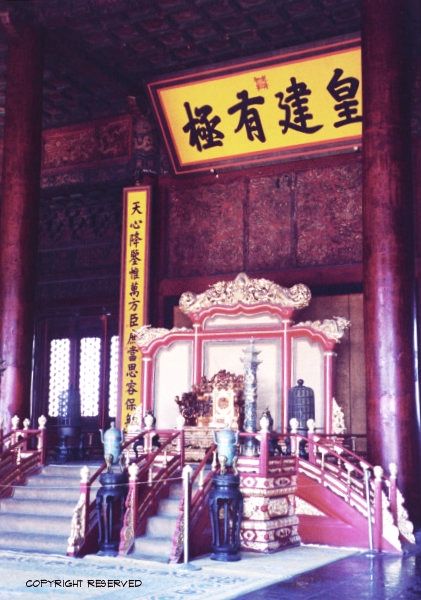 This is the Ceremonial Throne in the Hall of Supreme Harmony 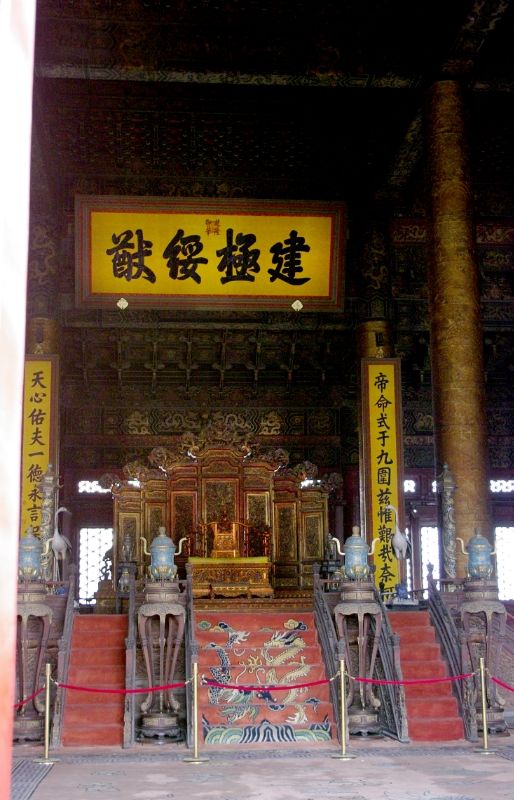 And this is yet another throne, this time in the Palace of Heavenly Purity 乾清宫 , where the Emperor held court. (The Empress lived separately and reigned over the Inner Palace in the Palace of Earthly Tranquility 坤宁宫.)  Above this throne is a plaque bearing the words that mean "Open and Above Board" (bottom right). Subsequent to the reign of Emperor Yong Zheng, the name of the successor of the throne, written personally by the Emperor, was kept in a box and secured behind this plaque. It was this plaque that supposedly held the will of Emperor Kangxi. According to the fable, Ying Zheng, the 4th prince, changed it will to his benefit, which was how he became enthroned Emperor instead of the 14th Prince. 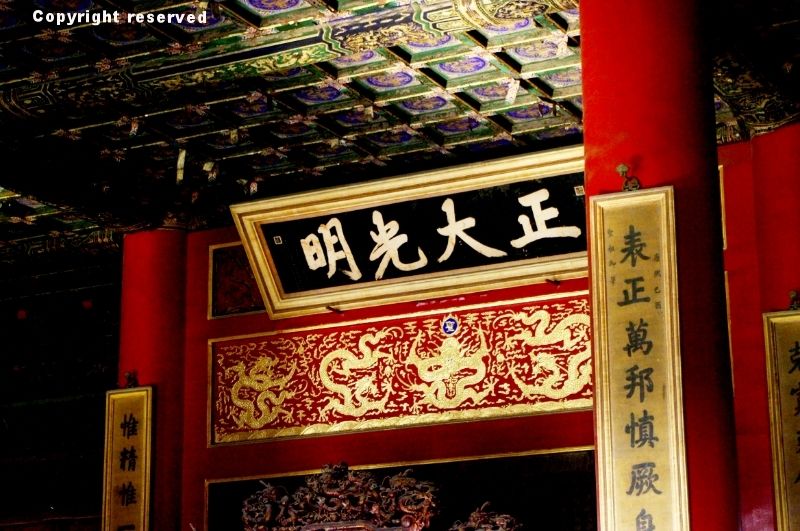 |
|
|
|
Post by chefying on Jul 7, 2014 13:29:19 GMT
The picture of the one throne I did not have is the one the Emperors used to do their big business...
|
|
|
|
Post by chefying on Jul 7, 2014 13:35:30 GMT
This is a picture of the Forbidden City's Wu Men, 午门 the Meridian Gate. This is one of the entrances into the Forbidden City. The Meridian Gate was where those who have annoyed the Emperor would lose their heads. 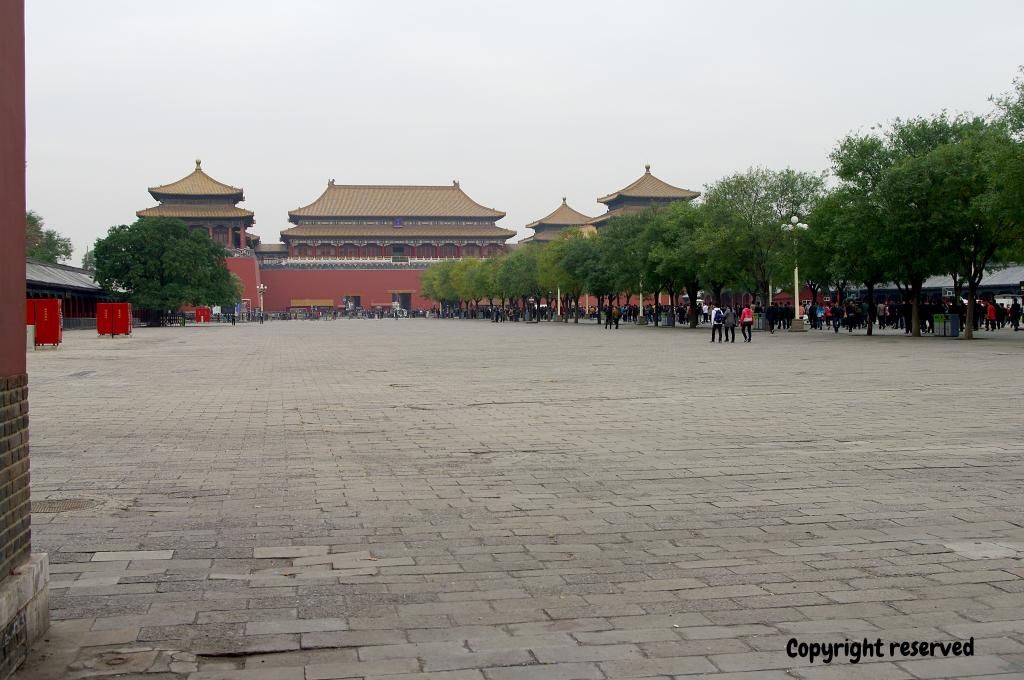 |
|






























